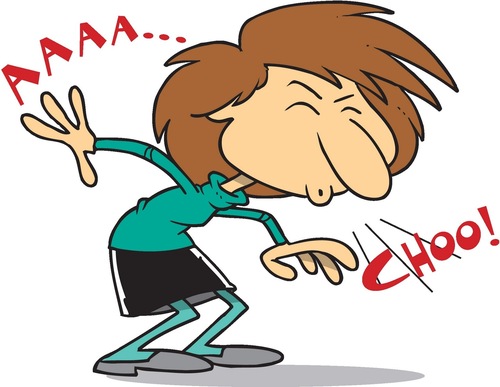Hay Fever!
An osteopath friend told me that some patients go to her because they hurt their backs when sneezing and coughing. I remembered this again now because the pollen count has been high so I have been suffering with hay fever over the last few weeks and have been sneezing a lot! My family and my pupils are used to me sneezing, often 8 times in a row, so I have had lots of time to think about how to look after myself when I do so.
During wintry weather, people with heavy coughs and colds may also seek the osteopath’s help – unless they find a way of avoiding this problem to begin with by looking after their backs, for instance through having Alexander Technique lessons. You may well ask ‘how can using the AT help you when you sneeze?’ Read on…..
Sneezing and Coughing Create Strong Spasms
One of the main reasons that back problems can happen when sneezing and coughing, is that when we hold ourselves in a fixed or twisted manner, with locked knees, contracted muscles and habitual tension in the lower, lumbar region of the back, this tightness will be increased by the spasms of coughing and sneezing. The spasms will obviously be more exaggerated if you have long bouts of coughing so that the jolting can strain your muscles, sometimes even damaging an intervertebral disc, causing great pain.
Bend Your Knees When You Cough and Sneeze!
However, if we learn to unlock our hips, knees and ankles so that they can bend, this can help our back to be freely lengthening, so the muscles are able to respond more elastically as our ribs expand and contract with the sneezing and the jolt can be softened so that it ripples through us, rather than straining us. This way of sneezing and coughing can also be helpful for people after having abdominal surgery, possibly with the addition of holding the abdomen for extra support during the sneeze – something I found incredibly helpful after having major surgery.
So I will sometimes, as a small part of their AT lessons, work with my pupils to help them find a way of sneezing and coughing so they look after their backs – yet another activity to explore performing with optimal body-use!
The more able you are to have free, balanced and elastic
body-use, unlocked knees and a free neck and back, the more resilient your muscles will be during and after each spasm. Remember to let the tension go again that inevitably built up during coughing and sneezing, so that you do not take that with you into your next activity.
Even if you have not had
Alexander Lessons and learned how to do this in a AT way, you can help protect your back if you remember to bend your knees, so you let your legs act as the shock absorbers they are designed to be.
